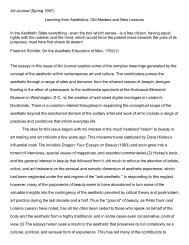Art Journal interview with Mick Wilson - Grant Kester
Art Journal interview with Mick Wilson - Grant Kester
Art Journal interview with Mick Wilson - Grant Kester
You also want an ePaper? Increase the reach of your titles
YUMPU automatically turns print PDFs into web optimized ePapers that Google loves.
9. <strong>Grant</strong> <strong>Kester</strong>, "Rhetorical Questions: The<br />
Alternative <strong>Art</strong>s Sector and the Imaginary Public"<br />
(1995), in <strong>Art</strong>m Activism, and Oppositionality: Essays<br />
from Afterimage, ed. <strong>Kester</strong> (Durham, NC: Duke<br />
University Press, 1998), 103-35.<br />
lengths in Conversation Pieces to lay out what I hope is a more nuanced model of<br />
community, but you continue to see critics invoking the ghost of a vulgarized<br />
Habermas to dismiss this practice out of hand. I have yet to encounter an artist<br />
who works in this manner who would claim that they are creating some sort of<br />
universal, immanent community that magically dissolves all differences. They<br />
tend to develop provisional "communities" through a shared, situational commitment.<br />
For critics weaned on [Emmanuel] Levinas or Nancy this skirts dangerously<br />
close to fascism. A lot of the misunderstanding comes from a tendency to<br />
collapse an analysis of community into a critique of hegemony, as if community<br />
or any collective formation can only ever be an expression of dominant power.<br />
We can't tolerate a concept of "immanent togetherness" based on the awful pos-<br />
sibility that we might have something in common-not everything, just something.<br />
The only ethical basis for overcoming our tendency to bash each other in<br />
the head is for us to acknowledge the fact that we have nothing in common and<br />
then, by a curious cognitive sleight of hand, to take that condition of existential<br />
isolation as the foundation for a nonfascistic community. This last part is particu-<br />
larly unclear to me, since I can imagine a completely opposite response: to use<br />
this perceived isolation as a kind of psychic justification to instrumentalize the<br />
Other. It seems less a description of utopian community than a symptom of<br />
the extreme fear of predication in the poststructuralist tradition.<br />
This quasi-evangelical attitude, what I call the postmodern "profession of<br />
faith" (or maybe faithlessness), is what allows for the synchronism between<br />
poststructuralist theory and the traditions of neoconceptual avant-garde art<br />
beginning in the i98os. The artist is, to use Lacan's phrase, "the subject presumed<br />
to know," bringing the viewer into compliance <strong>with</strong> a properly de-essentialized<br />
mode of being through some sort of revelatory encounter. The purism comes<br />
through quite clearly; the viewers must be punished for their reliance on forms<br />
of identification or collectivity that don't pass theoretical muster; they must be<br />
made to feel "discomfort," and so on. Of course this sort of S & M co-dependence<br />
between the artist and the viewer has a venerable history, extending back<br />
at least to Courbet's slap-in-the-face <strong>with</strong> The Stonebreakers. Provocation can easily<br />
enough slide over into titillation and one might argue that, at this late stage, art<br />
audiences expect, even anticipate, the shock, dislocation, and discomfort that<br />
avant-garde art delivers. Seldom has a population been so relentlessly "disrupt-<br />
ed," "challenged," and "destabilized" as the community of art cognoscenti who<br />
frequent biennials, Kunsthalles, and ICAs-and yet they keep coming back. This<br />
only seems odd if we ignore the rhetorical function of these provocations-<br />
something I tried to unpack a bit in the "Rhetorical Questions" essay. 9 That's why<br />
the work of someone like Sierra is so fascinating. The implied or ideal viewer for<br />
this work is clearly the art critic who is assigned the task of ventriloquizing the<br />
response that the viewer is "supposed" to have, while simultaneously standing<br />
<strong>with</strong> the artist, observing the benumbed viewer from a quasi-ethnographic<br />
remove. The relay of identifications and misidentifications that flow among the<br />
artist, the critic, and actual viewers of these works is quite complex, but it tends<br />
to be ignored. Instead we get the same credulous accounts of Sierra's installations<br />
as simple visual analogues for textual deconstruction, "revealing" or "exposing"<br />
the otherwise hidden operations of power.<br />
This really leads us back to your first question. The rapprochement between<br />
116 FALL 2007




